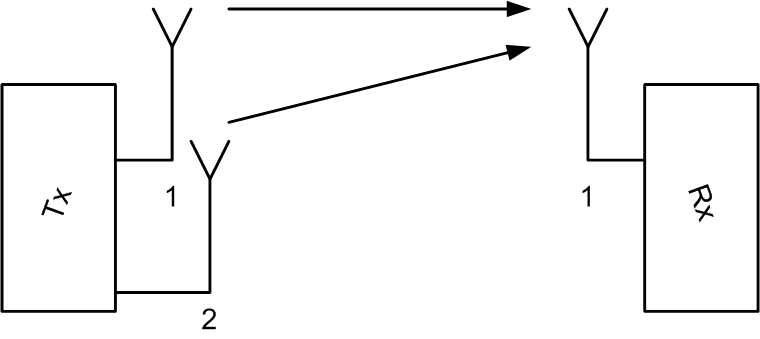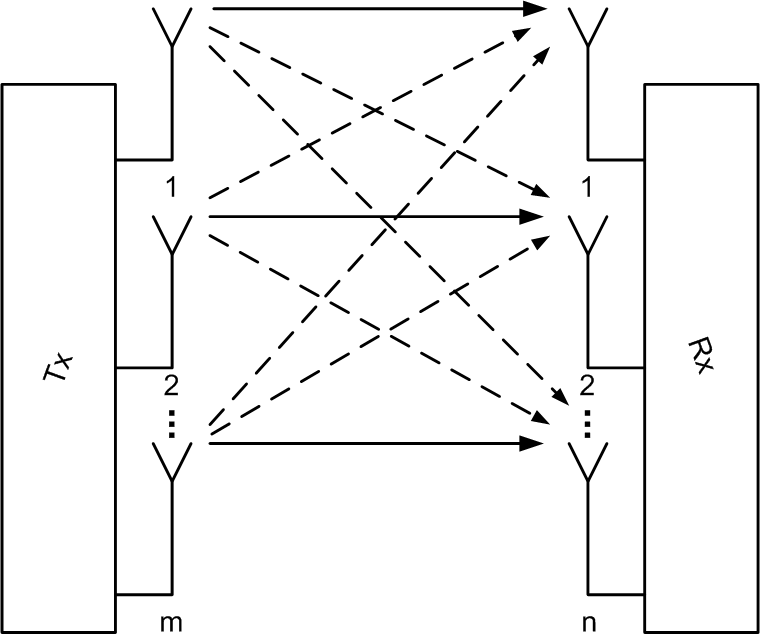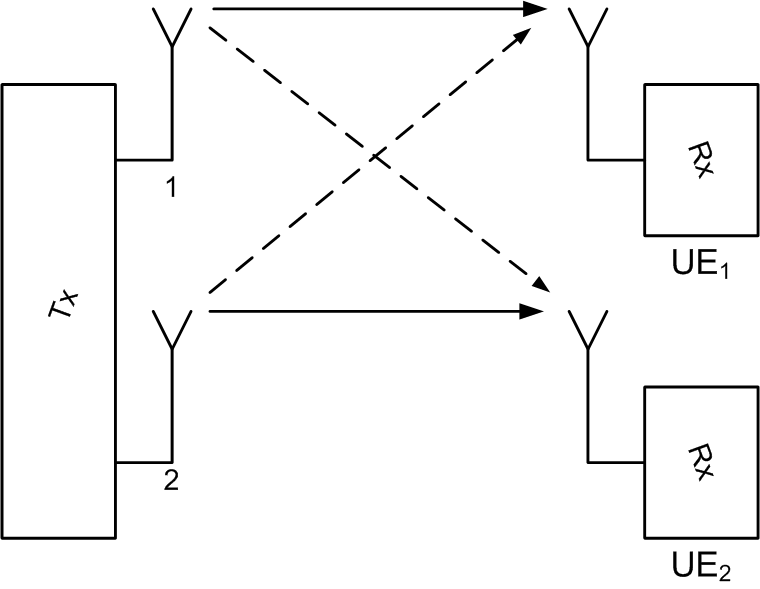MIMO Overview
Mobile traffic is continuously increasing pushing throughput requirements to mobile networks higher and higher. According to Ericsson Mobility Report (November, 2016) mobile data traffic CAGR will be 45% between 2016 and 2022 and will reach 69 EB/month. Most straightforward ways to increase networks capacity (except adding more eNBs which is not a cheap option) are: get and use a wider bandwidth; use higher order modulations (e.g. 64QAM, 256QAM). These ways can't fully meet actual throughput requirements as bandwidth is quite limited and higher order modulations need increased SINR (Signal to Interference plus Noise Ratio). Another way to increase network throughput and capacity is usage of multiple antenna techniques on both transmitter and receiver sides also known as MIMO (Multiple Input Multiple Output). Let's look at it in more details and consider MIMO variations.
SISO - Single Input Single Output
Let's start with single user MIMO system. The simplest and classic case is to use single transmitting (Tx) antenna and single receiving (Rx) antenna, it's shown on a picture below. Such system is called SISO - Single Input Single Output.
Channel capacity in this case can be calculated using Shannon theorem:
C = B⋅log2(1 + S/N), where
C - channel capacity (bits per second); B - channel bandwidth; S/N - signal to noise ratio.
Receive Diversity (Rx Diversity, SIMO - Single Input Multiple Output)
Rx Diversity - there are more Rx antennas than Tx antennas. Also such system is called SIMO - Single Input Multiple Output. The simplest example of such system is 1x2, i.e. there are one Tx antenna and two Rx antennas.
In 1x2 case there is no special signal processing on transmitter side, so it's quite simple from implementation point of view. However SIMO doesn't increase maximum throughput while reduces BLER (Block Error Rate). In case of 1x2 there are two signals on receiver side and it can be processed differently. For example, a signal with the better signal to noise ratio is chosen for further handling, this way called switched diversity. Another way is to combine two signals to improve signal to noise ratio, it's MRC - Maximum Ratio Combining.
Transmit Diversity (Tx Diversity, MISO - Multiple Input Single Output)
Tx Diversity - a case when there are more TX antennas than Rx antennas. Such system is called MISO - Multiple Input Single Output. The simplest example of MISO system is 2x1, i.e. there are two Tx antennas and one Rx antenna (see a picture below).
MISO (like SIMO) doesn't increase system throughput while increases transmission redundancy. In contrast to SIMO, MISO adds additional signal processing on transmitter side (for downlink channel it's eNB) instead of receiver complexing (mobile terminal).
Spatial Multiplexing, MIMO - Multiple Input Multiple Output
Spatial Multiplexing - in this case there are multiple Tx antennas and multiple Rx antennas and several different data streams are transmitted simultaneously. As opposed to MISO and SIMO, MIMO increases maximum throughput. However MIMO requires appropriate channel quality (i.e. MIMO doesn't work in case of low quality channels, in such cases either SIMO or MISO is used). On a picture below an example with m Tx antennas and n Rx antennas is shown.
Each receiver antenna gets all radio signals (dash lines on the picture above), not only one which addressed to a given antenna (a solid line on the picture above). If channel matrix is known, signals addressed to another antennas can be removed from received signal.
A number of different data streams that can be simultaneously transmitted depends on a number of available antennas. A number of different data streams can reach:
min(m, n), where
m - a number of Tx antennas; n - a number of Rx antennas.
For example, in case of MIMO 4x2 there can be only up to two different data streams that can be transmitted simultaneously while with MIMO 4x4 there can be up to four streams.
To calculate maximum throughput in MIMO system the following expression is used:
C = M⋅B⋅log2(1 + S/N), where
C - channel throughput; M - a number of different data streams transmitted simultaneously ; B - channel bandwidth; S/N - signal to noise ratio.
Also MIMO options can be classified from a number of simultaneously served users point of view. Single User MIMO (SU-MIMO) - MIMO is utilized to serve a single user, i.e. all data streams are addressed to one user only. While Multi User MIMO (MU-MIMO) - MIMO is utilized to serve a number of users at the same time using the same radio resources. In this case different data streams can be addressed to different users. A picture below shows an example of MU-MIMO in case of two users.

You can share your feedback, questions and/or proposals sending an email to alexey.anisimov86[at]gmail.com